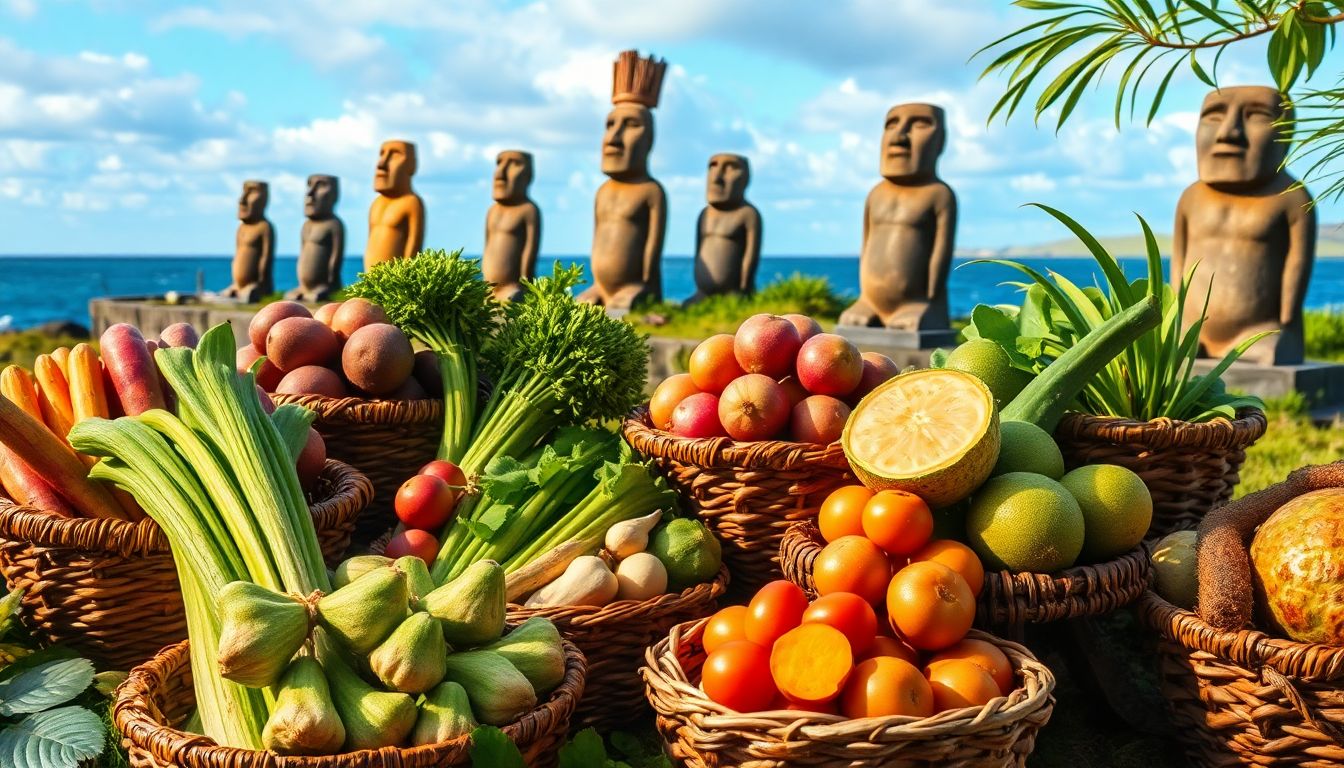
Uncovering the Easter Island Diet: Foods Before European Contact
Easter Island, famed for its majestic moai statues and remote location, has long captivated the imagination of scholars and travelers alike. The island’s isolation posed unique challenges for its original inhabitants as they sought to thrive in a land surrounded by the vast Pacific Ocean. Yet, the mystery of what these early islanders consumed remains an intriguing aspect of their history. This article dives into the pre-European diet of Easter Islanders, revealing a surprisingly rich tapestry of food sources shaped by their environment.
Despite its remoteness, Easter Island supported a diverse diet grounded in archaeological and botanical evidence. Let’s explore the key components of this fascinating culinary history.
The Importance of Sweet Potatoes (Kumara)
Kumara Cultivation: Evidence from archaeological digs
Sweet potatoes, or kumara, were vital to the diet of Easter Islanders. Archaeological findings confirm this staple crop flourished in the island's volcanic soil. Excavations reveal storage pits filled with kumara remnants, showcasing the crop’s significance.
The Role of Kumara in the Island's Economy and Social Structure
Kumara wasn’t just food; it played a pivotal role in the social fabric of the community. It became a symbol of wealth, often used in rituals and exchanges. The cultivation of kumara required extensive agricultural knowledge, reflecting the islanders' connection to their land.
Genetic analysis of Easter Island kumara and its origins
Recent genetic studies of kumara indicate its origins trace back to South America. This connection highlights the maritime skills of Easter Island’s inhabitants, who likely engaged in long-distance navigation for trade and resource-sharing.
Harnessing the Ocean's Bounty: Marine Resources
Fish Species Consumed: Specific examples and evidence from archaeological remains
The sea was a crucial resource, providing a variety of fish species. Archaeological remains show that Easter Islanders consumed tuna, parrotfish, and sea bass. These marine foods were essential to the community’s diet.
Fishing Techniques: Description of methods used and their effectiveness
Islanders employed various fishing techniques to catch their prey. They used nets, traps, and simple fishing lines. Evidence suggests they carefully navigated coastal waters, capitalizing on seasonal fish movements to ensure a steady food supply.
The Importance of Coastal Resources: Evidence suggesting coastal settlements and resource dependency
Coastal settlements flourished, reflecting the islanders' reliance on marine resources. Sites along the coastline reveal not only fish remains but also tools and artifacts related to fishing, emphasizing the ocean’s role in nourishing the community.
Beyond the Ocean: Terrestrial Food Sources
Bird Species: List of bird species consumed and evidence supporting their consumption
Bird hunting contributed significantly to the island's food options. Species such as seabirds and land birds, including the now-extinct Polynesian rat, were hunted for their meat and eggs. Evidence from archaeological sites indicates the importance of avian resources in their diets.
Insects and Other Invertebrates: Exploring the role of less commonly discussed food sources
While less glamorous, insects and invertebrates also formed part of the diet. The islanders likely consumed crabs, snails, and various insects, which provided essential nutrients during lean times.
Limited Terrestrial Plants: Discussing the challenges and diversity of plant life
Easter Island's restricted plant life posed challenges to food variety. Limited native vegetation meant the islanders had to rely on robust crops like kumara and their hunting skills. This limited biodiversity shaped their dietary choices profoundly.
The Role of Chicken in the Easter Island Diet
Introduction of Chickens: Likely timing and potential pathways of introduction
Chickens were likely introduced to Easter Island by Polynesian voyagers. Evidence suggests they arrived around the same time as the kumara, increasing the variety of available protein sources.
Chicken Farming Practices: Evidence for domestication and farming techniques
Chickens became an integral part of life. Archaeological data highlight structures that may have served as chicken coops, indicating domestication practices. They were raised not only for eggs but also as a source of meat for community feasts.
Chicken's Importance in the Economy and Culture
Chickens held cultural significance as well. Used in rituals and ceremonies, they represented an important link to the islanders' ancestral past.
Cannibalism: A Controversial Aspect of the Diet
Evidence for Cannibalism: Archaeological findings and their interpretations
Cannibalism, a shocking aspect of Easter Island's history, appears in archaeological evidence, including human bone remains. Signs of butchery suggest that cannibalism may have occurred during periods of extreme resource scarcity.
Reasons for Cannibalism: Hypotheses and debates among researchers
Scholars debate the reasons behind cannibalism, with theories ranging from ritualistic practices to survival during famines. This unsettling topic continues to spark discourse among researchers.
The ethical and social implications of interpreting cannibalism
The interpretations of cannibalism carry significant ethical weight. Understanding this aspect of the diet is essential for comprehending the challenges faced by Easter Islanders and the climate of their time.
Sustainable Practices and Environmental Impact
Evidence of sustainable practices: Discussion of techniques used for preserving resources
Easter Islanders employed sustainable practices to manage their resources. Rotational farming, selective harvesting, and natural resource conservation helped maintain ecological balance amid their agricultural and fishing activities.
The effects of deforestation and overexploitation: Potential impact on the diet and sustainability
However, deforestation and overexploitation took a toll. Evidence indicates that as resources dwindled, the dependency on unsustainable practices increased, leading to diminished food supplies.
Lessons from the past for modern resource management
Modern resource managers can learn from the Easter Islanders’ experiences. Balancing cultivation and conservation is vital to sustaining ecosystems.
Conclusion
In summary, the pre-European diet of Easter Island was diverse and complex. From sweet potatoes and marine resources to chickens and, controversially, cannibalism, these islanders adapted to their environment with remarkable resilience. Their food choices reflect not only their connection to the land and sea but also the challenges posed by their remote setting. As we continue to uncover the mysteries of Easter Island, the past offers insights that resonate even today, reminding us of the delicate balance between resources and sustainability.